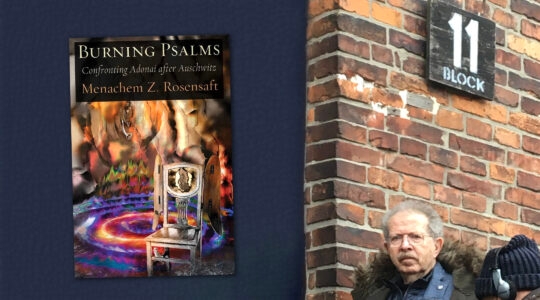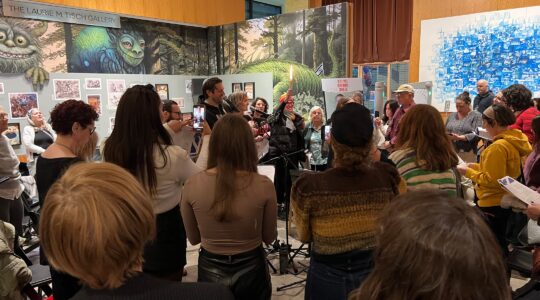About two-thirds of the way through the film “Forced March,” the director throws up his hands in despair about ever capturing the reality of the Shoah. “No matter how close we get, we can’t get close enough.”
This director isn’t Rick King, who was in charge of “Forced March.” He is Walter Hardy (John Seitz), the fictional character directing the film-within-a-film that is the narrative peg for “Forced March.” Originally released in 1989 “March” has a surprisingly post-modern conceit, that despite their best intentions neither Hardy nor his star Ben Kline (a refreshingly pensive Chris Sarandon) can actually reproduce the trauma of the murder of six million European Jews by the Nazis. As Ben’s father, a survivor (deftly played by Josef Sommer who is, as usual, a cut above his fellow cast members and his script), says in the film, “No one can show what it really was like.”
How well that notion has worn will be put to the test when the film is re-released Nov. 1. “Forced March” came early in the cycle of Shoah features, before “Schindler’s List,” “The Grey Zone” and so many others, which, together, created a Holocaust genre with its own instantly identifiable iconography, themes and narrative tropes. But it is not this film’s film’s radical take on issues of representation and realism that convinced its producers to bring it back in 2013. The film’s setting and specific subject, how the Shoah played out in Hungary and its impact on one of its most gifted victims, the poet Mikos Radnoti, which led producers Dick Atkins, Karl Bardosh and George Zelma to seek another theatrical release.
Bardosh and Zelma are Hungarian-American Jews who had worked together on some documentary projects, Bardosh as a filmmaker, Zelma as an attorney specializing in disability law. Each has an intimate family connection to the Shoah. Zelma’s mother was hidden from the Nazis until the last day of their occupation of Budapest, when she and 60 others were discovered. She didn’t tell him the outcome of that terrifying incident until she was near death in the United States a few years ago. Bardosh’s mother had an even more hair-raising escape, diving into a frozen river to make her Nazi captors think they had shot her along with others; the story turns up in the film with no significant departures from the reality.
Bardosh, an associate professor of film at NYU, says of the film’s intricate structure, “We tried to contemporize this experience for the next generation. That’s why we came up with idea of an actor who wants to use the making of the film [within the film] to understand what his parents went through, and to perform what the Jews in forced labor went through.”
At the same time, he notes, “I was touched by the story of somebody — Radnoti — who was a national poet shot by Hungarian soldiers with Nazi feelings — his own people! Two years later his wife and a friend helped identify his corpse in a mass grave, and in the pocket of his coat they found a notebook with an introduction he had written in five languages. He really wanted people to read these poems, to hear a testimony that literally came out of the grave, asking for it to be disseminated throughout the world.”
Perhaps it was naïve to think that with the fall of Communism, which began while the film was being shot in Budapest and the Hungarian countryside, that the anti-Semitism of Admiral Horthy (head of state from 1920-1944) and the Arrow Cross movement (in power from 1944-’45) would no longer reappear. As recent events have shown, Hungarian anti-Semitism withered away under Communism about as much as did the absolutist state.
“The revival of the film is motivated by the unfortunate timeliness it has in Europe,” Bardosh says emphatically. “The ugly head of racism and anti-Semitism has reared again. With the collapse of Communism you suddenly have free speech and one byproduct of that is that the anti-Semites come back out.”
Atkins, whose father was one of a detachment of GIs who liberated the Nordhausen concentration camp, points to the large Hungarian-American community in the Northeastern United States, which he sees hopefully as a target audience for the re-release.
“We think the film may have an impact on the Hungarian-Jewish community here,” he says. “Maybe that impact will filter back to Hungary.”
Bardosh adds, “Because the Jewish community in Hungary was nearly wiped out by the Shoah, the Hungarian Jews represent a small minority there, but here the Hungarian-American community is almost 50-50. So there is a substantial ethnic subculture that no longer exists in Hungary itself.”
As Jewish Week readers know, the right-wing government now in power in Hungary is striving to distance itself from its openly anti-Semitic allies in the Jobbik political party. Bardosh notes that the Hungarian consul and his New York staff are hoping to attend a screening of “Forced March.”
“They feel it is very important for them to show that the government is not on the side of the bad guys,” he says.
The public relations efforts of contemporary politicians aside, the producers are more eager to reach a young audience. Each of the three producers has a parent who wouldn’t talk about his or her experiences in the war and the Shoah. They consciously chose to structure their film around such a silence, creating in Ben Kline a stand-in for the audience, dismayed by the silence that greets its questions.
As the last of the survivors die, whether they have told their stories or not, Atkins says, “This movie is more relevant now than it was 25 years ago.”
“Forced March” directed by Rick King, opens on Friday, Nov. 1, at the Quad Cinema (34 W. 13th St.). For information, call (212) 255-2243, or go to www.quadcinema.com.
The New York Jewish Week brings you the stories behind the headlines, keeping you connected to Jewish life in New York. Help sustain the reporting you trust by donating today.




